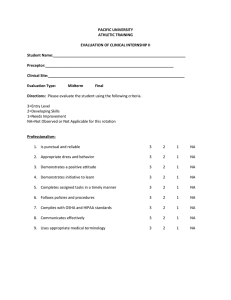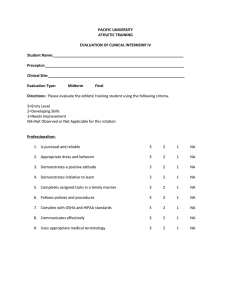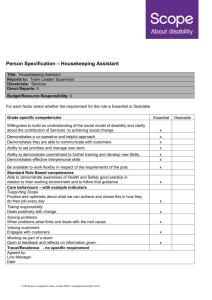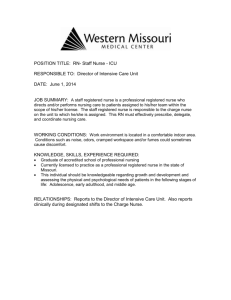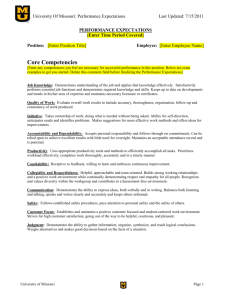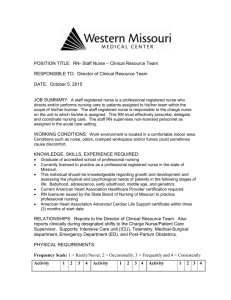NURS 186/NURS 187 Preceptor Checklists of Skills and Competencies
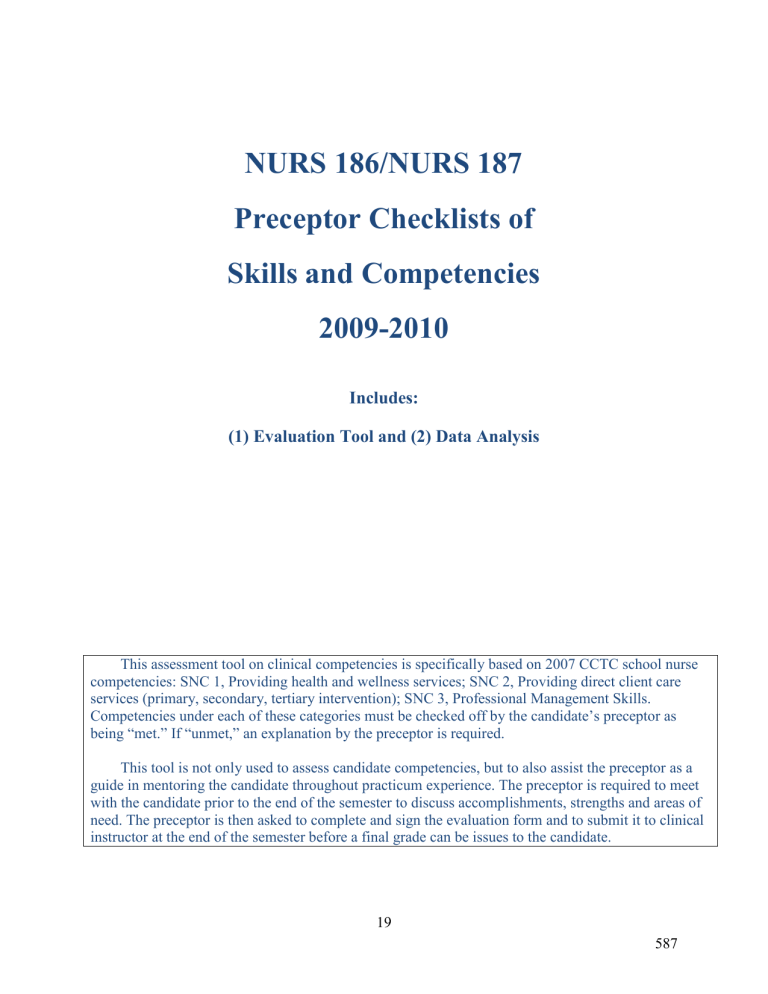
NURS 186/NURS 187
Preceptor Checklists of
Skills and Competencies
2009-2010
Includes:
(1) Evaluation Tool and (2) Data Analysis
This assessment tool on clinical competencies is specifically based on 2007 CCTC school nurse competencies: SNC 1, Providing health and wellness services; SNC 2, Providing direct client care services (primary, secondary, tertiary intervention); SNC 3, Professional Management Skills.
Competencies under each of these categories must be checked off by the candidate’s preceptor as being “met.” If “unmet,” an explanation by the preceptor is required.
This tool is not only used to assess candidate competencies, but to also assist the preceptor as a guide in mentoring the candidate throughout practicum experience. The preceptor is required to meet with the candidate prior to the end of the semester to discuss accomplishments, strengths and areas of need. The preceptor is then asked to complete and sign the evaluation form and to submit it to clinical instructor at the end of the semester before a final grade can be issues to the candidate.
19
587
1.
EVALUATION TOOL - ELEMENTARY
N186 PRECEPTOR CHECKLIST OF SKILLS AND COMPETENCIES -ELEMENTARY
It is important that every effort be made to complete the clinical experiences indicated in each of the following areas. The preceptor must witness the student completing the procedure, assessment, and/or work. If the student does not have the opportunity to complete an experience, the preceptor is to discuss the area in depth and determine that the student has sufficient knowledge of the subject matter. If the student has had two or more years of school nursing experience at the elementary level and explains/demonstrates to the preceptor’s satisfaction that he/she is competent in a particular area, the preceptor may choose to sign the student off with comments below indicating his/her satisfaction with the student’s level of knowledge/competence.
School Nurse Competencies 1. Providing Health and Wellness Services (Primary Intervention)
E1 Organizes and correctly performs screening for the following:
Met
Y N Date
Vision - near/far, color, muscle
Hearing, including thresholds
Functional vision & hearing
Dental
Met
Y N Date
Comment if not met
Preceptor initials
Nutritional Assessment Height, Weight, BMI
*Competency in each of the above areas must be demonstrated under direct observation the preceptor.
E2 Correctly carries out the Nursing Process in problem solving matters related to program; and in health assessment of clients, which includes developmental history taking, assessment of growth & development, nutritional status, etc.
E3 Correctly assesses pupil immunization status upon entry to kindergarten and correctly describes immunization requirements for entry into middle school.
Demonstrates/explains accurately reporting requirements/written report.
E4 Correctly assesses CHDP status at the first grade level, demonstrates understanding for follow-up and report obligation.
E5 Demonstrates ability to develop an age appropriate lesson plan and carry out a health teach in the classroom in keeping with district policy and Ed Code.
E6 Correctly identifies relevant community health agencies, services, and programs.
Demonstrates leadership ability to assist children and families in accessing appropriate community resources.
E7 Assists with and/or properly trains and supervises medication administration and permissible tasks and procedures by UAPs (unlicensed assistive personnel).
E8 Discusses the importance of environmental safety and is able to identify environmental areas that illicit safety concerns. Describes emergency steps taken in the event of a violent incident or an intruder on the school grounds,
E9 Describes the emergency steps that the school site in the event of a serious personal injury, i.e., instructions, directing emergency equipment, information that needs to accompany injured party(s), role of the school nurse.
E10 Expresses understanding for Universal Precautions and communicable disease control district policies.
E11 Expresses insight into the role of the SN as a participant in providing coordinated health services and school health programs to better manage limited resources.
E12 Demonstrates ability to promote mental health among school age children and school staff through recognition of need, assessment, counseling, health education, and referral to appropriate services.
E13 Demonstrates ability to promote healthy nutrition and a healthy lifestyle among students and staff through modeling, health promotion and health education.
E14 Demonstrates the ability to promote oral health among school age children through participating in oral health assessment programs, through health promotion, and health education.
E15 Describes signs of child abuse/neglect. Explains reporting guidelines, paperwork involved, and names agencies involved.
E16 Explains the SARB process and takes the appropriate steps to follows up on absenteeism and encourage school attendance.
20
588
E17 Makes appropriate home visit to follow up on absenteeism and/or as member of an IEP team to complete assessment. Demonstrates ability to establish rapport with family.
E18 Demonstrates sensitivity and understanding with regard to cultural differences among the student population, communicates and counsels effectively with individual students from various cultural backgrounds.
E19 Describes the socio cultural and ethnic differences in the student population and is able to link tendency for certain health problems to individual groups.
School Nurse Competencies 2. Providing Direct Client Care Services (Secondary and Tertiary Intervention)
Met
Y N Date Comments/ Initials
E20 Demonstrates competence in providing appropriate healthcare services to students coming to the health office and others in the school setting.
E21 Demonstrates ability to assist in use of and/or interprets the following:
Asthmatic equip – inhaler, spacer, nebulizer, Peak flow meter
Diabetic equip – insulin syringe, insulin pump, glucometer, carb counting
Emergency equipment, i.e. defibrillator
Explain if other:
E22 Demonstrates ability to respond to emergencies involving students/staff
Met
Y N Date
Met
Y N Date
Asthma attack Insulin reaction
Grand Mal seizure
Fracture/sprain
Head injury, spinal injury
Sickle Cell emergency
Loss of permanent tooth
Eye injury
Chemical/2 nd
or 3 rd
degree burn
Allergic reaction
Explain if other:
*Competency for each (E21 and E22) must be demonstrated under direct observation by the preceptor.
E23 Demonstrates competence in managing acute injuries and other medical emergencies; assesses and provides appropriate emergency first aid.
E24 Demonstrates competence in caring for students with chronic health problems, and in formulating appropriate Individual Healthcare Plans and Emergency Action
Plans that ensures child safety and optimal learning.
E25 Demonstrates competence in caring for the medically fragile and competently carries out specialized physical health care procedures, i.e., tracheostomy care, gastrostomy feedings, a clean catheterization.
E26 Demonstrates competence in managing children identified as having a communicable disease condition, makes good judgment calls in following through with school population, referral, and follow-up.
E27 Demonstrates ability to case manage the multifaceted health care needs of a child, i.e., assists families with affordable health care and coordinating services within the school and community.
E28 Demonstrates ability to participate as a member of the SST, IEP team and completes appropriate assessment and paperwork for an IEP and 504 plan.
E29 Demonstrates competence in administering medication in the school setting, states
5 rights, proper storage, management, and documentation.
E30 Describes the alarm system that signals a school wide emergency and the action steps that students and staff need to take in the event of a school wide or natural disaster, threat of an intruder, and the school nurse role.
Comments:
21
589
School Nurse Competencies 3. Professional Management Skills
E31 Demonstrates leadership and the ability to use professional knowledge, skills, and ethical decision making to promote the overall health of the school community and of individuals.
Comments:
E32 Describes a realistic plan for organizing and implementing an overall school health program that considers uniqueness of population and cultural differences.
Comments:
E33 Reiterates (give examples of) legal guidelines of school nursing practice, i.e., sections of Ed. Code, other state and federal laws as they applied to health services, program planning, health promotion and teaching.
Comments:
E34 Demonstrates ability to model evidence-based healthcare practices in the delivery of school nursing services (research), as well as use a theoretical base to guide practice.
Comments:
E35 Demonstrates the ability to advocate appropriately with students, families, community, and others to promote healthy behaviors and lifestyles.
Comments:
E36 Demonstrates ability to communicate with clarity and professionally, both orally and in writing, with professionals, families, and students.
Comments:
E37 Demonstrates ability to work in a collaborative and collegial manner with others in a public education system, with understanding for the structure and authority of school district administration.
Comments:
E38 Demonstrates ability to organize and maintain accurate and complete health records.
Comments:
E39 Demonstrates the ability to use time effectively, and manage fiscal and personnel resources prudently.
Comments:
E40 Demonstrates the ability to train, supervise, and monitor others who may assist students in taking medication and/or provide specialized physical healthcare procedures to students.
Comments:
5
Excellent = 5 and Poor =1
4 3
Time spent in other settings. Check areas that apply. (Students to discuss in journal)
Clinic held at school site, i.e. immunization, dental screening Infant stimulation program (0-3 years)
Community agencies, i.e. CCS, CVRC, other Preschool program
Faculty/school staff in-service Student Attendance Review Board
Conducted health teaching in a classroom School nurse in-services, conferences
2 1
22
590
NURS 186, School Nurse Practicum I, Preceptor Checklist Cont.
Practicum time must add up to 80 hours for a student currently employed as a school nurse, 120 hours for a student not currently employed as a school nursing, 100 hours for a practicing PHN.
Preceptors must approve the following student activities away from direct supervision:
Time spent by school nurse student in a leadership activity/project not specified in Student Goals and Objectives (max. 10 hrs.)
An Experienced School Nurse Project. Preceptor must sign off on completion (max. 20 hrs). Points earned for a completed project will be determined by the student’s clinical instructor following review.
Time spent participating in community activities, visiting agencies and/or programs (8-10 hrs.)
School nurse workshops/conferences (10-12 hrs.)
Please complete the following related to hours:
No. of hours spent under your direct supervision providing health services at a school site?
No. of hours spent with your guidance in completing a leadership activity or Ex SN Project?
No. of hours spent with your recommendation participating in community activities/SN meetings?
Total Number of Hours
Taking all practicum activities into consideration, rate the total performance of this student:
Excellent Very Good Good Fair Poor
Circle no. 5 4 3 2 1
List areas in which the student may need further mentoring/experience:
Would you recommend this student for credentialing? Yes __________ No __________
Additional comments:
Preceptor Signature ______________________________________Date _________________
Completed evaluation must be faxed or mailed to clinical instructor after a preceptor conference with student to discuss outcomes of practicum experience and before the end of the semester. Fax completed evaluation forms to the attention of the clinical instructor at (559) 278-1013; or mail to the attention of the clinical instructor to CSU, Fresno
Dept. of Nursing, 2345 E. San Ramon Ave, M/S MH 25, Fresno, CA 93740-8031.
23
591
2.
EVALUATION TOOL - SECONDARY
N187 PRECEPTOR CHECKLIST OF SKILLS AND COMPETENCIES (SECONDARY)
It is important that every effort be made to complete the clinical experiences indicated in each of the following areas. The preceptor must witness the student completing the procedure, assessment, and/or work. If the student does not have the opportunity to complete an experience, the preceptor is to discuss the area in depth and determine that the student has sufficient knowledge of the subject matter. If the student has had two or more years of school nursing experience at the secondary level and explains/demonstrates to the preceptor satisfaction that he/she is competent in a particular area, the preceptor may choose to sign the student off with comments below indicating his/her satisfaction with the student’s level of knowledge/competence.
Providing Health and Wellness Services (Primary Intervention)
Comment if not met
Met Date
Y N
Preceptor initials
S1 Correctly carries out the Nursing Process in problem solving and in assessing and caring for preadolescents/adolescent students in the school setting.
S2 Demonstrates competency in planning, organizing, and conducting mass screening to detect deviations from norm related to vision, hearing, scoliosis, and Acanthosis Nigricans
S3 Demonstrates the ability to develop age appropriate health curriculum/lesson plan and competently teaches or facilitates a group discussion(s) in keeping with district policy and the Ed Code.
S4 Correctly identifies relevant community resources for adolescent population and makes appropriate referrals.
S5 Properly trains/supervises medication administration and procedures carried out by unlicensed personnel.
S6 Explains insight into importance of campus security and describes issues, i.e., gang activity, weapons on campus, other.
S7 Demonstrates an understanding for emergency steps in school wide emergencies, i.e., natural disasters, bomb threats
S8 Utilizes effective communication skills and sensitivity when assisting/counseling with adolescents, families, and staff.
S9 Identifies appropriate programs/services for students/families with special needs/problems (e.g., mental health, family planning needs, prenatal care).
S10 Takes leadership role in assisting and referring students and families to appropriate services within the community
S11 Demonstrates ability to promote healthy nutrition and a healthy lifestyle among adolescents and staff through modeling, health promotion, and health education at the secondary level.
24
592
S12 Discusses various health issues associated with different types of athletic activities and nutritional requirements.
S13 Expresses insight into the SN role in participating in the development and execution of coordinated health education programs and screening programs, keeping socio-cultural issues and budget constraints in mind.
S14 Describes at least 5 things related to organizing and implementing an overall school health program at the secondary level.
S15 Demonstrates ability to promote mental health among adolescents and school staff through recognition of need, assessment, counseling, and referral for appropriate services.
S16 Participates in reporting of suspected child abuse, including that which relates to unlawful sexual activity/abuse, including date rape. Discusses laws regarding reporting sexual activity among minors.
S17 Describes signs and symptoms of at least 3 types of substance abuse, assessment steps, reporting and referral guidelines, and an appropriate referral agency(s) for substance abusers and support group(s) for families.
S18 Discusses issues associated with adolescent absenteeism and the role of the school nurse in preventing school drop-out. Describes various alternative programs to help teens/young adults complete schooling.
SNC 2. Providing Direct Client Care Services (Secondary and Tertiary Intervention)
Met
Y N
S19 Demonstrates ability to provide healthcare services to students and emergency and/or first aid assistance to others in the school setting.
S20 Demonstrates the ability to properly evaluate and manage various types of sports injuries, including acute injuries, makes appropriate referral.
S21 Relates insight into behavioral, emotional, and mental health issues that affect adolescents, uses appropriate counseling techniques and referrals to appropriate professional within the school and community.
S22 Describes signs/symptoms of at least 2 types of eating disorders. Given the opportunity, demonstrates appropriate counseling techniques, contacts the correct individuals and refers appropriately.
S23 Describes signs of depression and suicide threat. Demonstrates ability to use appropriate counseling techniques and guidelines regarding sharing confidential information in the best interest of the individual and others.
25
Comments
593
Describes appropriate contacts and referral.
S24 Demonstrates ability to counsel pregnant teens, with knowledge of confidential guidelines, cultural issues, insight into assistance programs and agencies, and to promote healthy behaviors and school attendance.
S25 Describes the emergency steps taken by school administrators/personal and the school nurse in the unlikelihood event of a natural disaster in your area.
What outside agencies that could be involved?
(earthquake, flood, fire)
S26 Uses the appropriate, confidential and culturally sensitive counseling techniques with students suspected of having an STD, makes referral to appropriate community agency. Discusses issues related to possible contacts.
S27 Demonstrates ability to case manage the multifaceted health related needs of an adolescent and/or family i.e., financial assistance, appropriate services, and relevant programs, while keeping socio-cultural issues in mind.
S28 Describes role of the school nurse in making sure that students properly take/use medication how/when ordered, including self-carry.
S29 Demonstrates understanding for needs of wheelchair bound individuals and students dependent on other types of health related equipment and assistance, i.e. learning materials, access to facilities, toileting, body alignment issues.
S30 Describes the role of the school nurse as a member of the school crisis team in planning, responding, and participating in a crisis intervention at school.
School Nurse Competencies 3. Professional Management Skills
S31 Demonstrates leadership and the ability to use professional knowledge, skills, and ethical decision making to promote health among students and staff at the secondary level.
Comments:
S32 Demonstrates the ability to work creatively with others in the school community within the public education system to promote healthy behaviors and lifestyles among adolescents and staff at the secondary level.
S32 Comments:
S33 Demonstrates the ability to model evidence-based healthcare practices in the delivery of school nursing services at the secondary level (research), as well as to use a theoretical base to guide practice.
Comments:
5
Excellent = 5 and Poor = 1
4 3 2 1
26
594
S34 Discusses legal guidelines and gives examples in school nursing practice as they relate to HIPAA, FERPA, IDEA, confidentiality, student rights, health ed.
Comments:
S35 Demonstrates the ability to work well with adolescents as evidenced through a show of sensitivity towards their emotional, social, cultural, and developmental needs.
Comments:
S36 Expresses understanding for what is involved in creating and maintaining a comprehensive school health services program at the secondary level.
Comments:
S37 Demonstrates a global understanding for the role of the school nurse as it relates to school and community, i.e. collaboration, communication, use of resources.
Comments:
S38 Demonstrates ability to work in a collaborative and collegial manner with others at the secondary level.
Comments:
S39 Demonstrates the ability to communicate effectively in writing and verbally, and make clear oral presentations to a wide variety of audiences.
Comments:
S40 Demonstrates the ability to use time effectively, adapt to new and unanticipated situations, and to manage fiscal and personnel resources prudently.
Comments:
Time spent in other settings. Check areas that apply. (Students to discuss in journal)
Community/juvenile court school School nurse in-services/conferences
Continuation high School Program for emotionally disturbed
Drug intervention program Faculty/staff in-service, School Council mtg.
Health/career fair planning, participation Student Attendance Review Board
School nurse in-services/conferences Teen pregnancy/parenting program
Health teaching in a classroom Facilitated a small group
27
595
NURS 187, School Nurse Practicum II, Preceptor Checklist Cont.
Practicum time must add up to 80 hours for a student currently employed as a school nurse, 120 hours for a student not currently employed as a school nursing, 100 hours for a practicing PHN.
Preceptors must approve the following student activities away from direct supervision:
Time spent by school nurse student in a leadership activity/project not specified in Student Goals and Learning Objectives
(max. 10 hrs.)
An Experienced School Nurse Project. Preceptor must sign off on completion (max. 20 hrs). Points earned for a completed project will be determined by the student’s clinical instructor following review.
Time spent participating in community activities, visiting agencies and/or programs (8-10 hrs.)
School nurse workshops/conferences (10-12 hrs.)
Please complete the following related to hours:
No. of hours spent under your direct supervision providing health services at a school site?
No. of hours spent with your guidance in completing a leadership activity or Ex SN Project?
No. of hours spent with your recommendation participating in community activities/SN meetings?
Total Number of Hours
Taking all practicum activities into consideration, rate the total performance of this student:
Excellent Very Good Good Fair Poor
Circle no. 5 4 3 2 1
List areas in which the student may need further mentoring/experience:
Would you recommend this student for credentialing? Yes __________ No _________
Additional comments:
Preceptor Signature ______________________________________Date _________________
Completed evaluation must be faxed or mailed to clinical instructor after a preceptor conference with student to discuss outcomes of practicum experience and before the end of the semester. Fax completed evaluation forms to the attention of the clinical instructor at (559) 278-1013; or mail to the attention of the clinical instructor to CSU, Fresno
Dept. of Nursing, 2345 E. San Ramon Ave, M/S MH 25, Fresno, CA 93740-8031.
28
596
2. DATA ANALYSIS
Assessment of Preceptor Checklist of Skills and Competencies for NURS 186, School Nurse
Practicum I – Elementary, and Preceptor Checklist of Skills and Competencies for NURS
187, School Nurse Practicum II – Secondary, will be presented together as follows:
Note : The skills and competencies checklists for NURS 186 and NURS 187 were revised for the
2009-2010 academic year to reflect the new CCTC 2007 recommended candidate competencies.
Because of the likeness in the NURS 186 and NURS 187 evaluation tools, though specific to each educational level for each practicum, they will be discussed and present together.
NURS 186 & NURS 187 Preceptor Checklist of Skills and Competencies are divided into 3 sections.
The following two sections each has a comprehensive list of skills and competencies that must be observed and checked off by the candidate’s preceptor as “Met” or “Unmet.”
* School Nurse Competencies I: Providing
Health and Wellness Services (Primary
Intervention) Examples of expected candidate competencies in this category for both N186 &
N187:
“ Organizes and correctly performs state mandated screening, i.e., vision, hearing, scoliosis.”
“Correctly carries out the nursing process in problem solving matters related to program; and in health assessment of clients, which includes history taking, growth & development, nutritional status.”
* School Nurse Competencies 2 category:
; Providing Direct
Client Care (Secondary & Tertiary Intervention).
Examples of expected candidate competencies in this
“Demonstrates competence in providing appropriate healthcare services to students coming to the health office and others in the school setting.”
”Demonstrates competence in assessment and management of acute injuries and other medical emergencies; and provides appropriate emergency first aid.”
* School Nurse Competencies 3 , Professional Management Skills.
Competence in this area is determined by a 5 point Likert scale. The 10 questions for used for both practicum courses, though they relate specifically to elementary school nursing for NURS 186 and secondary school nursing for NURS 187. See following data outcomes for School Nurse Competencies 3.
29
597
* School Nurse Competencies 3, Professional Management Skills
Taking all practicum activities into consideration, rate the total performance of this candidate using the following scale.
Key: 5 = Excellent; 4 = Very good; 3 = Good; 2 = Fair; 1 = Poor
Elementary
NURS 186, Practicum I (Elementary) and NURS 187
(Secondary)
Fall 2009 Spring 2010
1
Number of candidates 36 Total 36 Total
5 4 3 2 1 5 4 3 2 1
Demonstrates leadership and the ability to use professional knowledge, skills, and ethical decision making to promote the
34
94
2
6
0 0 0 35
97
1
3
0 0 0 overall health of the school community and of individuals.
2 Describes a realistic plan for organizing and implementing an overall school health program that considers uniqueness of population and cultural differences.
%
32
88
%
%
4
1
2
%
0 0 0 35
97
%
%
1
3
%
0 0 0
3
4
5
6
Reiterates (give examples of) legal guidelines of school nursing practice, i.e., sections of Ed. Code, other state and federal laws as they applied to health services, program planning, health promotion and teaching.
Demonstrates ability to model evidence-based healthcare practices in the delivery of school nursing services (research), as well as use a theoretical base to guide practice.
Demonstrates the ability to advocate appropriately with students, families, community, and others to promote healthy behaviors and lifestyles.
Demonstrates ability to communicate with clarity and professionally, both orally and in writing, with professionals, families, and students.
30
83
%
34
94
%
35
97
%
32
88
%
1
3
%
4
1
2
%
%
2
6
%
1
7
%
6 0 0 0 34
94
%
0 0 0 33
92
%
0 0 0 35
97
%
0 0 0 33
92
%
2
6
%
3
8
0 0 0
0 0 0
%
1 0 0 0
3
%
3
8
%
0 0 0
7 Demonstrates ability to work in a collaborative and collegial manner with others in a public education system, with understanding for the structure and authority of school district administration.
8 Demonstrates ability to organize and maintain accurate and complete health records.
36
100
%
0 0 0 36
100
%
Secondary
0 0 0 0 36
100
%
0 0 0 0
0 0 0 0
9
10
Demonstrates the ability to use time effectively, and manage fiscal and personnel resources prudently.
Demonstrates the ability to train, supervise, and monitor others who may assist students in taking medication and/or provide specialized physical healthcare procedures to students.
94
%
35
97
%
34
94
%
34
6
%
1
3
%
2
6
%
2 0 0 0 35
97
%
0 0 0 33
92
%
1
3
%
3 0 0 0
8
%
0 0 0
30
598
Final evaluation of candidate performance, 4
Was the preceptor satisfied that the candidate demonstrated that he/she was capable of satisfactorily meeting required competencies/skills?
Taking all activities into consideration, rate total candidate performance
5
36
100
%
4 3 2 1 5
0 0 0 0 36
100
%
4 3 2 1
0 0 0 0
32
88
%
4
1
2
%
0 0 0 34
94
%
2
6
%
0 0 0
Would you recommend this candidate for a Clear Credential? Yes – 36 =
100%
Yes –
36=100%
Summary of finding:
In NURS 186 (Elementary) - Preceptors rating candidate clinical performance as 5 “Excellent” (88%) or 4
“Very Good” (12%); no candidates were rated 3 “Good,” 2 “Fair,” or 1“Poor” in any category.
In NURS 187 (Secondary) – Preceptors rated candidate clinical performance as 5 “Excellent” (94%) or 4
“Very Good” (6%). No candidates were rated in the 3 “Good,” 2“Fair,” or 1“Poor” categories.
31
599
